 This
is White Dome Geyser. White Dome is just down the street from Great
Fountain Geyser, and it's eruptions (like this one) are easily visible
from Great Fountain, so if you wait on Great Fountain to erupt like I was
doing this afternoon, you will very likely see White Dome too. It
has one of the largest cones of any geyser, a twenty foot cone which sits
on an older 12 foot high broad mound that was formed by either a non erupting
hot spring or a fountain type geyser. Geyser cones grow very slowly,
an inch per century is an often quoted figure. Although certainly
there is much variation in geyser cone growth rates, White Dome must be
very old. I like to imagine that White Dome was once a powerful fountain
type geyser like Great Fountain, but has nearly sealed itself off.
It might be true. The water is thrown at most 30 feet into the air.
The eruptions are frequent, usually every 15 to 30 minutes, but irregular.
It's cone is the symbol of the Yellowstone Association.
This
is White Dome Geyser. White Dome is just down the street from Great
Fountain Geyser, and it's eruptions (like this one) are easily visible
from Great Fountain, so if you wait on Great Fountain to erupt like I was
doing this afternoon, you will very likely see White Dome too. It
has one of the largest cones of any geyser, a twenty foot cone which sits
on an older 12 foot high broad mound that was formed by either a non erupting
hot spring or a fountain type geyser. Geyser cones grow very slowly,
an inch per century is an often quoted figure. Although certainly
there is much variation in geyser cone growth rates, White Dome must be
very old. I like to imagine that White Dome was once a powerful fountain
type geyser like Great Fountain, but has nearly sealed itself off.
It might be true. The water is thrown at most 30 feet into the air.
The eruptions are frequent, usually every 15 to 30 minutes, but irregular.
It's cone is the symbol of the Yellowstone Association.
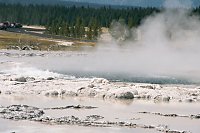 The
Great Fountain Geyser Crater, or at least half of it. Great Fountain
erupts from a 16 foot wide pool that sits in the center of a series of
raised circular terraces. The sinter formations are quite impressive
and beautiful, and shots of a non erupting Great Fountain are a staple
of Yellowstone postcards and calendars, especially with the setting
sun reflecting off the water in the catch basins. The Geyser begins
to overflow about 60 to 90 minutes before an eruption. Watch and
listen for the water trickling from upper to lower catch basins to see
if it is in overflow. Sometimes it is easier to hear than see.
As the time for eruption nears, the pool begins to have periods of boiling
around the edges.
The
Great Fountain Geyser Crater, or at least half of it. Great Fountain
erupts from a 16 foot wide pool that sits in the center of a series of
raised circular terraces. The sinter formations are quite impressive
and beautiful, and shots of a non erupting Great Fountain are a staple
of Yellowstone postcards and calendars, especially with the setting
sun reflecting off the water in the catch basins. The Geyser begins
to overflow about 60 to 90 minutes before an eruption. Watch and
listen for the water trickling from upper to lower catch basins to see
if it is in overflow. Sometimes it is easier to hear than see.
As the time for eruption nears, the pool begins to have periods of boiling
around the edges.
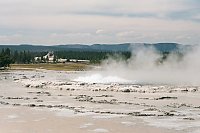 With
each episode of boiling, the boiling is a little more vigorous. Great
Fountain is a predicted geyser. The predictions are posted at the
Old Faithful Visitor Center, and also on a sign by Great Fountain.
It's interval can vary from 9 to 16 hours, depending on the length of the
previous eruption. See White Dome in the background?
With
each episode of boiling, the boiling is a little more vigorous. Great
Fountain is a predicted geyser. The predictions are posted at the
Old Faithful Visitor Center, and also on a sign by Great Fountain.
It's interval can vary from 9 to 16 hours, depending on the length of the
previous eruption. See White Dome in the background?
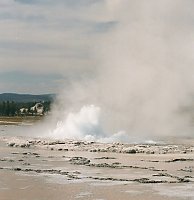 When
the boiling gets this vigorous get ready.
When
the boiling gets this vigorous get ready.
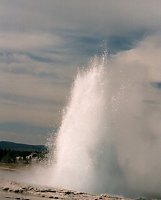 Finally
water bursts into the air. Great Fountain is a fountain type geyser,
so rather than a steady stream of water from a cone, it's eruption consists
of separate bursts of water from a pool. In Great Fountain's case
the pool looks empty after the first few bursts. Great Fountain will
have a series of bursts lasting for say five or ten minutes. The
bursts are not particularly rapid fire, and they can vary widely in height.
Some may be only a few feet high. Most eruptions have bursts in the
neighborhood of 100 feet, and exceptional eruptions can exceed 200 feet.
They are also thrown out at varying angles. It is kind of fun to
try to anticipate the geyser's next move, but it makes for difficult photography.
After the five or 10 minutes of activity i falls quiet for a few minutes.
Then it starts again. It will go through several cycles of activity
followed by a pause, with each cycle tending to be a bit weaker. The eruption
ends after anywhere from 30 to 90 minutes.
Finally
water bursts into the air. Great Fountain is a fountain type geyser,
so rather than a steady stream of water from a cone, it's eruption consists
of separate bursts of water from a pool. In Great Fountain's case
the pool looks empty after the first few bursts. Great Fountain will
have a series of bursts lasting for say five or ten minutes. The
bursts are not particularly rapid fire, and they can vary widely in height.
Some may be only a few feet high. Most eruptions have bursts in the
neighborhood of 100 feet, and exceptional eruptions can exceed 200 feet.
They are also thrown out at varying angles. It is kind of fun to
try to anticipate the geyser's next move, but it makes for difficult photography.
After the five or 10 minutes of activity i falls quiet for a few minutes.
Then it starts again. It will go through several cycles of activity
followed by a pause, with each cycle tending to be a bit weaker. The eruption
ends after anywhere from 30 to 90 minutes.
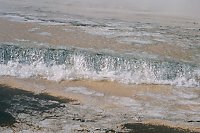 After
the first couple of bursts of water, a wave finally reaches the edge of
the terraces around the geyser.
After
the first couple of bursts of water, a wave finally reaches the edge of
the terraces around the geyser.
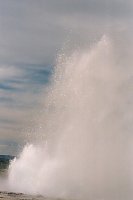 More
of Great Fountain playing.
More
of Great Fountain playing.
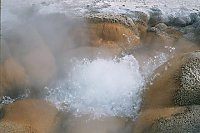 After
watching Great fountain for a good long while, we made a late afternoon
visit to Biscuit Basin. This is Shell Spring, a small geyser.
Shell is a cyclic geyser, one that has a series of eruptions separated
by a quiet phase. It is usually erupting, and right next to the boardwalk.
After
watching Great fountain for a good long while, we made a late afternoon
visit to Biscuit Basin. This is Shell Spring, a small geyser.
Shell is a cyclic geyser, one that has a series of eruptions separated
by a quiet phase. It is usually erupting, and right next to the boardwalk.
It also may be the spring a a three year old girl stepped into
and was scalded to death in 1932. She and her parents were waiting
for nearby Jewel geyser erupt, and when it did, stepped back and the child
fell into the spring up to her neck. Seriously parents, watch your
kids around these things. Consider a leash. I say it may be
the spring because while Shell Spring is in a location and is a size that
agrees with the accounts of the accident, the reports of the day say the
pool was only 150 degrees, and it looks considerably hotter than that now.
Of course things can change in 70 years.
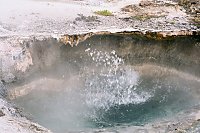 A
little farther down the boardwalk is Silver Globe Spring. It is also
a small geyser. Note the overhang above the pool. Overhanging
edges are kind of common around Yellowstone's hot springs, another good
reason to keep the children on a leash.
A
little farther down the boardwalk is Silver Globe Spring. It is also
a small geyser. Note the overhang above the pool. Overhanging
edges are kind of common around Yellowstone's hot springs, another good
reason to keep the children on a leash.
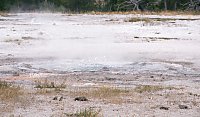 This
small geyser in the northern part of the Biscuit basin is unnamed.
This
small geyser in the northern part of the Biscuit basin is unnamed.
 Some
algae in the runoff of Sapphire Pool.
I thought it was kind of pretty.
Some
algae in the runoff of Sapphire Pool.
I thought it was kind of pretty.
back to the Yellowstone Pictures Page